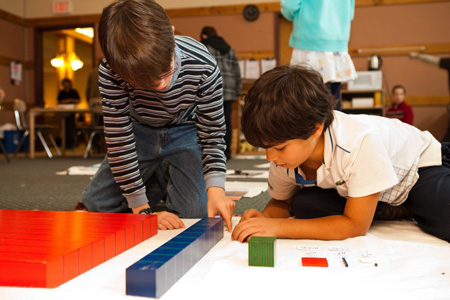Dr. Montessori believed that “the hands are the tools of the mind” and created an approach to learning which engages each child in the two-fold process of purposeful activity and intellectual development. In Education for a New World, Dr. Montessori recognized that,
“Mind and movement are two parts of a single cycle; and movement is the superior expression. … If through force of circumstances the child cannot use his hands, the child remains incapable of obedience or initiative, lazy and sad, whereas the child who can work with his hands shows firmness of character.”
Being a father of a nine year old boy and a Montessori educator, I read with great interest what has become a popular theme growing both in notoriety and credibility, schools at every level of education are failing boys.
 By almost every benchmark, boys across the nation and in every demographic group are falling behind. In elementary school, boys are two times more likely than girls to be diagnosed with learning disabilities and twice as likely to be placed in special-education classes. High-school boys are losing ground to girls on standardized writing tests. The number of boys who said they didn’t like school rose 71 percent between 1980 and 2001, according to a University of Michigan study. Nowhere is the shift more evident than on college campuses. Thirty years ago men represented 58 percent of the undergraduate student body. Now they’re a minority at 44 percent. This widening achievement gap, says Margaret Spellings, U.S. Secretary of Education, “has profound implications for the economy, society, families and democracy.”
By almost every benchmark, boys across the nation and in every demographic group are falling behind. In elementary school, boys are two times more likely than girls to be diagnosed with learning disabilities and twice as likely to be placed in special-education classes. High-school boys are losing ground to girls on standardized writing tests. The number of boys who said they didn’t like school rose 71 percent between 1980 and 2001, according to a University of Michigan study. Nowhere is the shift more evident than on college campuses. Thirty years ago men represented 58 percent of the undergraduate student body. Now they’re a minority at 44 percent. This widening achievement gap, says Margaret Spellings, U.S. Secretary of Education, “has profound implications for the economy, society, families and democracy.”
Yet in this modern age the industrial model for classroom learning remains relatively unchanged in conventional schools. This model has increasingly favored girls and comes up short for boys. The Montessori education model, on the other hand, has always had a hands-on activity based approach to learning that is ideally suited to boys (and girls, for that matter). The Montessori approach recognizes the behavioral tempo of individuals and accommodates it by allowing students to move freely about the classroom. With this freedom comes greater responsibility which students embrace and which aids in the independent learning process. The motivation for hard work and accomplishment grows from the excitement and interest of the students, not from the external motivators such as grades or advanced placement.
In this age of educational accountability there is an ever increasing parent population who measure school success by test scores and advanced placement. Schools have been forced by regulations to respond by giving even the youngest students frequent standardized assessments. In schools across the nation homework has increased, curriculums have become more rigid, there are widespread cutbacks in physical education and sports programs and even recess has become a thing of the past.
In the last two decades, the education system has become obsessed with a quantifiable and narrowly defined kind of academic success, these experts say, and that myopic view is harming boys. Boys are biologically, developmentally and psychologically different from girls and teachers need to learn how to bring out the best in every one.
Our first born is a girl, relatively calm, consistent and at times contemplative. Our boy, on the other hand, is a bundle of kinetic energy who jumps from one thing to another effortlessly. I am a member of a growing body of parents that are concerned that boys are being forced to fit a failing approach to education that is better suited to girls.
In elementary-school classrooms, where teachers increasingly put an emphasis on language and a premium on sitting quietly and speaking in turn, the mismatch between boys and school can become painfully obvious.
“Girl behavior becomes the gold standard,” says Raising Cain coauthor Michael Thompson. “Boys are treated like defective girls.”These new pressures are undermining the strengths and underscoring the limitations of what psychologists call the “boy brain”, the kinetic, disorganized, maddening and sometimes brilliant behaviors that scientists now believe are not learned but hard-wired.
In Montessori schools the children learn through interaction in the environment, learning environments that Dr. Montessori designed as “scientifically planned and methodically formed”. The teacher is a guide, and a part of the learning environment. The materials are not visual aids for the teacher, but rather tools for the students. In this same book cited above and written in 1946, Dr. Montessori was both prophetic and insightful, even for today. She said that activity in schools: … must form part of education, especially today, when people seldom walk but go in cars or vehicles of some sort, so that there is a tendency to paralysis and sloth. Life may not be cut in two, moving the limbs for sport, and then the mind for reading. Life must be one whole, especially at an early age, when the child is constructing himself.
Kathy Stevens, co-author of The Minds of Boys: Saving Our Sons From Falling Behind in School and Life, backs up claims that there is a “crisis in male education.” “Boys have a ‘biological imperative’ to move more,” Stevens says, “because they have 15 percent more spinal fluid.” “Their body is really an extension of their brain”. “Boys are unable to follow directions as well as girls do.” she says, “Boys get identified from the get-go as behavior problems, ADD. Maybe he’s just a boy and he can’t just sit still.” Most teachers believe if the children are sitting quietly, good teaching must be happening. “That’s absolutely false,” she says. “How quiet the classroom is has nothing to do with how much learning is going on.” She says it’s important to create more experiential lessons and to make sure kids participate in activities like recess, music and art.
In Real Boys: Rescuing Our Sons from the Myths of Boyhood, author and psychologist William Pollack presents his findings from almost 20 years of clinical work and his recently completed study examining contemporary boyhood and the ways boys manifest their social and emotional disconnection through anger and violence. He stresses that changing teaching methods to accommodate boys does not mean hindering girls. Girls, he says, often enjoy the same hands-on activities. “We have the data about learning-style differences and behavior-style differences,” he says. “This is not a win-lose circumstance. It’s not teachers against parents, parents against schools, boys against girls. It’s a win-win. We recognize what we now know and use it.”
“By addressing who a boy really is and what he really needs, a school can make a difference in helping him do well academically, feel positive about himself and develop a healthy sense of masculinity. A positive school experience, in short, can bolster a boy’s self-esteem.” “Boys have a unique learning style that is different from that of girls. Research suggests that, whereas many girls may prefer to learn by watching or listening, boys generally prefer to learn by doing, by engaging in some action-oriented task. I’ve observed boys who are so resistant to reading books in class that they’ll literally toss them aside to pursue more hands-on activities. I’ve also seen boys who, though identified as “lazy readers,” became active, proficient readers when given material on subjects that interested them, such as sports, adventure stories and murder mysteries. Most critically, I believe we must make absolutely sure that for every boy there is a “good fit” between what makes him thrive as an individual and what his school actually provides for him.”
He could easily be making a case for the method of teaching at a Montessori School.
Paul Raymond is the Head of Quest Montessori School and a Montessori educator for over 30 years. Quest Montessori is now celebrating its 9th year and temporarily housed at the South Road School in Wakefield while it builds the first architect designed Montessori School in Rhode Island that will open for the 2012-13 school year in the North End of Narragansett.










This is really very helpful for bloggers
You’re doing a great job Man, Keep it up.
I really appreciate this article. My husband and I have been discussing the idea of Montessori over conventional schooling for some time now, given our son’s tendency to learn while doing. (And his inability to sit still… and I don’t mean that in a bad way.) This provides us with some more information we haven’t had before. Thank you!